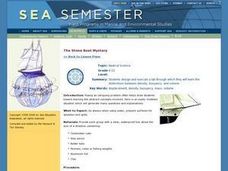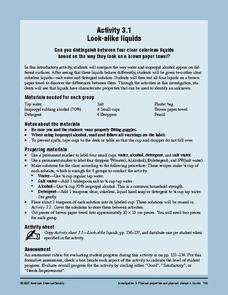American Chemical Society
Investigating the Line
Note that this lesson is best paired with the preceding lesson in the unit. In that lesson, elementary physical scientists observed that the color coating of M&Ms® candies do not mix when dissolved off of the chocolate surface. Now...
Texas State University
Earth: Deposition and Lithification
Geology geniuses analyze sediment samples with a hand lens and sort according to physical characteristics. They also learn about the processes of cementation, compaction, and lithification within the rock cycle. The lesson plan is...
Cornell University
Predicting Chemical Reactions
Prove the Law of Conservation of Mass through a lab investigation. A well-designed lesson asks groups to combine materials and monitor indicators for chemical reactions. Measuring the mass of the reactants and products allows individuals...
Curated OER
Acid-Base Indicators
The first two pages provide a chart to complete with results of a lab test using different solutions and indicators. The data analysis questions will help your students understand the concentrations of the solutions and how they affect...
Curated OER
The Stone Boat Mystery
Students design and execute a lab through which they study the distinctions between density, buoyancy, and volume.
Curated OER
Pollution or Prevention?
Students examine potential contamination on the environment due to products and by-products of a new industrial process. Students conduct a lab that explores the economic differences between choices of pollution cleanup and prevention.
Curated OER
Count Marsili & the Mediterranean Current
Young scholars integrate history and science while discovering how salinity affects the density of water. After a lecture/demo, students work in groups to complete a lab activity that demonstrates how salinity affects the density of water.
Curated OER
The Ellipse
This is a practical sheet with the instructions to draw a set of ellipses. After following the diagrams, there are ten questions to complete, with calculations expected for alternate orbits and comparisons related to actual planets in...
Curated OER
Comparing Pulse Rates
Students participate in a lab that demonstrate one example of how the human body maintains homeostasis. Students collect data from themselves and observe how their own bodies react to exercise.
Curated OER
Changing Planet: Withering Plants - Stressing Over Lost Water
Expectant earth scientists examine the bottom side of a leaf and learn the role of the stomata. They consider the gas exchange that occurs through these structures and relate how the climate is changing to its impact on food crops. This...
Curated OER
Semipermeable Membranes and Bioaccumulation
Beginning biologists place a drop of food coloring into water of differing temperatures to observe the effect on the diffusion rate. They remove the shells from raw eggs and then experiment with osmosis over the remaining membranes....
Curated OER
Mass-Mass Relationship
Students investigate mass-mass relationships in the lab. In this mass-mass relationship lesson plan, students mix sodium carbonate with hydrochloric acid to produce sodium chloride, water and carbon dioxide. Students use the amount of...
Next Generation Science Storylines
Why Do Some Things Get Colder (or Hotter) When They React?
Some reactions absorb heat while others release it. Young scholars investigate both types of reactions in a 12-lesson unit. Each lesson presents a lab investigation that monitors temperature and considers the types of reactions taking...
Curated OER
Igneous Rock Lab
In this igneous rock worksheet, students answer 5 questions about igneous rocks and then use a website to find the 6 textures of igneous rock. Students record data such as the color, the texture, if it's intrusive or extrusive, if its...
Concord Consortium
Protein Folding Exploring
The potential energy of peptides varies over time as they fold. An exploratory simulation encourages pupils to play with various strands of amino acids to observe the folding and potential energy levels. Young scientists generate all...
Curated OER
Blood Circulation Lab
Learners investigate blood moving in the fin of a fish. In this blood circulation lesson, students use a goldfish wrapped in water soaked absorbent cotton, placed in a large petri dish, then placed until a lighted microscope in order to...
Curated OER
Introduction to Materials Science
Learners locate, identify and describe the purpose and proper use of all safety equipment in the classroom. They describe the processes involved in following the scientific method, and classify matter according to natural or synthetic...
Curated OER
Experiment Report (Normal Form)
Here is a handy handout to give any science class as a guide to writing lab reports. It is a blank outline that you can have aspiring scientists fill out when they experiment, or imitate as they record their experiments in a lab journal....
Curated OER
An Introduction to Microbes and Microbes Are Everywhere
Seventh graders define the term microbe. They identify the five main groups of microbes. Students give examples of ways in which microbes have impacted or currently impact human life. They create a hypotheses for where they expect to...
Curated OER
Comparing Mitosis with Meiosis
Life science learners view an online animated mini textbook comparing two types of cell division. Working in groups, they use a digital microscope to capture images of cells in different stages of mitosis and meiosis. Then they create an...
Curated OER
Life in Extreme Environments - Who is on Top in the Food Chain?
Young scholars discuss the design of experiments to determine how much and how fast rotifers feed and design experiments with a lab partner and in small collaborative groups. They then collect data from experiments and present results of...
American Chemical Society
Dissolving a Substance in Different Liquids
Second of six lessons in a unit on dissolving, this one focuses on how sugar behaves in different liquids. Learners stir it into water, alcohol, and oil and make observations. This lesson can stand alone, but is best used as part of the...
American Chemical Society
Look-Alike Liquids
Here is the first of four experiments to differentiate among unknown liquids by their behaviors and properties. Pupils observe how different liquids respond to being placed on plastic and paper, and they take notes about their...
American Chemical Society
Using Chemical Change to Identify an Unknown
If you have taught the first lesson in this mini unit, learners already know that cabbage juice and vinegar cause chemical changes in some materials. Now, they get a chance to use them to compare the liquids' reactions to five known and...

























